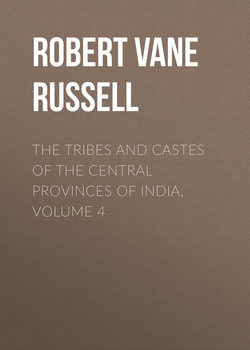Читать книгу The Tribes and Castes of the Central Provinces of India, Volume 4 - Robert Vane Russell - Страница 69
Part II
Articles on Castes and Tribes
Kumhār—Yemkala
Vol. IV
Kurmi
30. Religion. Village gods
ОглавлениеThe caste worship the principal Hindu deities. Either Bhagwān or Parmeshwar is usually referred to as the supreme deity, as we speak of God. Bhagwān appears to be Vishnu or the Sun, and Parmeshwar is Siva or Mahādeo. There are few temples to Vishnu in villages, but none are required as the sun is daily visible. Sunday or Raviwār is the day sacred to him, and some people fast in his honour on Sundays, eating only one meal without salt. A man salutes the sun after he gets up by joining his hands and looking towards it, again when he has washed his face, and a third time when he has bathed, by throwing a little water in the sun’s direction. He must not spit in front of the sun nor perform the lower functions of the body in its sight. Others say that the sun and moon are the eyes of God, and the light of the sun is the effulgence of God, because by its light and heat all moving and immobile creatures sustain their life and all corn and other products of the earth grow. In his incarnations of Rāma and Krishna there are temples to Vishnu in large villages and towns. Khermāta, the mother of the village, is the local form of Devi or the earth-goddess. She has a small hut and an image of Devi, either black or red. She is worshipped by a priest called Panda, who may be of any caste except the impure castes. The earth is worshipped in various ways. A man taking medicine for the first time in an illness sprinkles a few drops on the earth in its honour. Similarly for the first three or four times that a cow is milked after the birth of a calf the stream is allowed to fall on the ground. A man who is travelling offers a little food to the earth before eating himself. Devi is sometimes considered to be one of seven sisters, but of the others only two are known, Marhai Devi, the goddess of cholera, and Sitala Devi, the goddess of smallpox. When an epidemic of cholera breaks out the Panda performs the following ceremony to avert it. He takes a kid and a small pig or chicken, and some cloth, cakes, glass bangles, vermilion, an earthen lamp, and some country liquor, which is sprinkled all along the way from where he starts to where he stops. He proceeds in this manner to the boundary of the village at a place where there are cross-roads, and leaves all the things there. Sometimes the animals are sacrificed and eaten. While the Panda is doing this every one collects the sweepings of his house in a winnowing-fan and throws them outside the village boundary, at the same time ringing a bell continuously. The Panda must perform his ceremony at night and, if possible, on the day of the new moon. He is accompanied by a few other low-caste persons called Gunias. A Gunia is one who can be possessed by a spirit in the temple of Khermāta. When possessed he shakes his head up and down violently and foams at the mouth, and sometimes strikes his head on the ground. Another favourite godling is Hardaul, who was the brother of Jujhār Singh, Rāja of Orchha, and was suspected by Jujhār Singh of loving the latter’s wife, and poisoned in consequence by his orders. Hardaul has a platform and sometimes a hut with an image of a man on horseback carrying a spear in his hand. His shrine is outside the village, and two days before a marriage the women of the family visit his shrine and cook and eat their food there and invite him to the wedding. Clay horses are offered to him, and he is supposed to be able to keep off rain and storms during the ceremony. Hardaul is perhaps the deified Rājpūt horseman. Hanumān or Mahābīr is represented by an image of a monkey coloured with vermilion, with a club in his hand and a slain man beneath his feet. He is principally worshipped on Saturdays so that he may counteract the evil influences exercised by the planet Saturn on that day. His image is painted with oil mixed with vermilion and has a wreath of flowers of the cotton tree; and gugal or incense made of resin, sandalwood and other ingredients is burnt before him. He is the deified ape, and is the god of strength and swiftness, owing to the exploits performed by him during Rāma’s invasion of Ceylon. Dūlha Deo is another godling whose shrine is in every village. He was a young bridegroom who was carried off by a tiger on his way to his wedding, or, according to another account, was turned into a stone pillar by a flash of lightning. Before the starting of a wedding procession the members go to Dūlha Deo and offer a pair of shoes and a miniature post and marriage-crown. On their return they offer a cocoanut. Dūlha Deo has a stone and platform to the east of the village, or occasionally an image of a man on horseback like Hardaul. Mirohia is the god of the field boundary. There is no sign of him, but every tenant, when he begins sowing and cutting the crops, offers a little curds and rice and a cocoanut and lays them on the boundary of the field, saying the name of Mirohia Deo. It is believed among agriculturists that if this godling is neglected he will flatten the corn by a wind, or cause the cart to break on its way to the threshing-floor.
